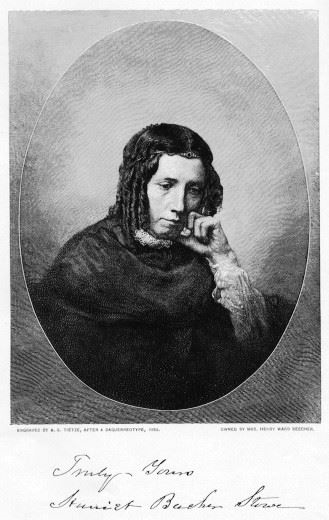 |
| Harriet Beecher Stowe (www.uh.edu/engines/stowe.jpg) |
Author, teacher, daughter, wife, and mother, Harriet Beecher Stowe embodies the character counts pillar of fairness. Born June 14, 1811 in Litchfield, Connecticut, Harriet lived a meaningful life until her death on July 1, 1896 in Hartford, Connecticut at the age of 85 years. As the seventh child of a famous protestant preacher, Harriet learned the values exemplified in the six pillars of character: trustworthiness, respect, responsibility, fairness, caring, and citizenship. She took this foundational knowledge with her as she “moved to Cincinnati, Ohio, in 1832, where she taught at the Western Female Institute” (Harriet, n.d., 1). Shortly thereafter, she met and married a fellow teacher at the institute: Calvin Ellis Stowe. In 1850, with her husband’s new position at Bowdoin College, they moved to Brunswick, Maine, setting the stage for the most prolific antislavery writing the world would ever see. This venture marked the beginning of a life-long commitment to fight for the rights of the oppressed including slaves and women, to fight for fairness. Armed with first-hand accounts from living across the river from Kentucky, a slave state, she began the battle for humanizing slaves. Her weapon: a pen; her shield: parchment.
 |
| Uncle Tom's Cabin (www.uh.edu/engines/epi1206.htm) |
In 1851, Harriet Beecher Stowe, with the encouragement of her husband, opened the eyes of Americans and Europeans to the horrors of slavery. When the dust settled and the ink dried, the result of her war rested on the surface of her battleground: a collection of words entitled Uncle Tom’s Cabin. This novel personalized the suffering that slaves forcefully endured. As Davis (2003) states, “no other literary work since 1776, when Tom Paine’s Common Sense incited a wave of pro-independence fervor, had the political impact of Uncle Tom’s Cabin” (p. 203). Harriet’s poignant characters and vivid scenes jolted “tears from even the most heartless” (Davis, 2003, p. 202). Her novel’s personal portrayal of slavery cultivated the need for the Union to band together in a Civil War against the Southern Confederacy. Her battle fought with pen and parchment would soon become the country’s war.
With the Civil War fast approaching, 1861-65, strong beliefs regarding slavery, and in particular, its economic impact on the United States of America, continued to escalate. Intensity grew when another log plunged into the fire in 1851; a series of articles written by Harriet Beecher Stowe received a spotlight in the National Era, an abolitionist journal. A unique fuel to the fire, this serial form of Uncle Tom’s Cabin ignited a spirit of compassion never before seen regarding blacks and slavery. In the year following its transformation into book form, “300,000 copies” sold and altogether, over “1.5 million copies [sold] worldwide” (Davis, 2003, p. 202). Regardless of clear disdain, copies sold out in the South. Bitter feelings raged over this ‘inaccurate’ portrayal of slavery. As a result, Stowe wrote “A Key to Uncle Tom’s Cabin (1853) extensively documenting the realities on which the book was based, to refute critics who tried to argue that it was inauthentic” (Ockerbloom, n.d., 2). Harriet impacted America by writing from personal experiences, creating clear and simple characters, reflecting the complexities of the culture, and painting accurate, meaningful scenery through her words. Due to these strengths, Uncle Tom’s Cabin “is considered to be the most famous example of antislavery literature” (Harriet, n.d., 2).
This profound example of antislavery sentiments left a lasting legacy. It catapulted America into the Civil War. As quoted in Davis (2003), Abraham Lincoln reportedly stated in 1862 that Harriet Beecher Stowe was the “little woman that wrote the book that made this great war” (p. 203). In addition, the legacy continued in three amendments: Amendments Thirteen, Fourteen, and Fifteen. These amendments abolished slavery (1865), extended citizenship to former slaves (1868), and gave black males the right to vote (1870), respectively (Davis, 2003, p. 606-607). With the Union’s victory in the Civil War and the personal accounts of the inhumanity of slavery from the book, Congress was able to pass these three amendments relatively quickly. Even with expedient ratification, these amendments remain a part of the written documents that lay the foundation of our country today. Consequently, the legacy of Uncle Tom’s Cabin continues. Without this foundational literary work, the Civil War may have remained strictly focused on power, control, and the economic influences of slavery. Instead, the rights of black men, women, and children pressed to the forefront of congressional minds because of Harriet’s fight for fairness and the humanity she encapsulated in her famous literary work. We are reminded in Uncle Tom’s Cabin to think of African Americans’ “freedom every time [we] pass Uncle Tom’s Cabin and let it be a memorial to try to live as honestly and faithfully as Tom with God as [our] leader” (Liberton, 1996, 12).
 |
Through Uncle Tom’s Cabin, a cornerstone in American rights, Harriet Beecher Stowe opened the eyes of Americans. As a means to bring the bondage of slavery to the forefront, Uncle Tom’s Cabin excelled. This controversial literary work “focused public interest on the issue of slavery” and its horrors (Ockerbloom, n.d., 2). With a persistence driven by a need to create fairness in our country, Harriet wrote a novel to humanize the suffering of slaves through personal portrayals of real, distinct characters. Due to the way it opened readers’ eyes, her book changed history: it enabled blacks to make strides toward equality. The lasting legacy of Uncle Tom’s Cabin rests in the Thirteenth, Fourteenth, and Fifteenth Amendments, which grant African Americans the rights they deserve: the same rights as European Americans. Fairness.
Page created on 5/1/2009 12:00:00 AM
Last edited 5/1/2009 12:00:00 AM
Davis, Kenneth. Don't Know Much About History: Everything You Need to Know About American History But Never Learned. New York: HarperCollins, 2003.
unknown. "Harriet Beecher Stowe House." [Online] Available http://www.nps.gov/history/nr/travel/underground/me1.htm.
Liberton, Dana. "Harriet Beecher Stowe's Uncle Tom's Cabin." [Online] Available http://bradley.bradley.edu/~dlb/dlstowe.html. 1996.
Ockerbloom, Mary. "Harriet Beecher Stowe: 1811-1896." [Online] Available http://digitallibrary.upenn.edu/women/stowe/StoweHB.html.
